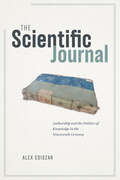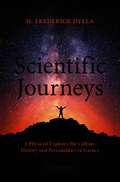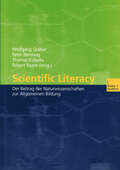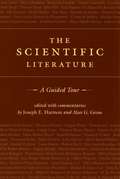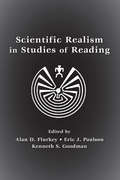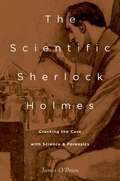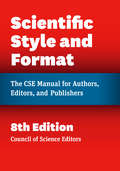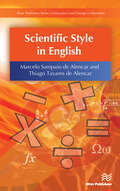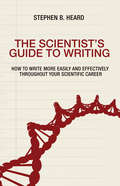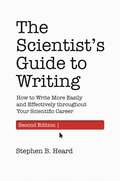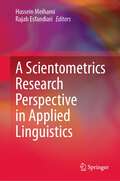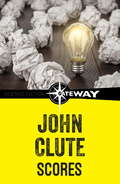- Table View
- List View
The Scientific Journal: Authorship and the Politics of Knowledge in the Nineteenth Century
by Alex CsiszarNot since the printing press has a media object been as celebrated for its role in the advancement of knowledge as the scientific journal. From open communication to peer review, the scientific journal has long been central both to the identity of academic scientists and to the public legitimacy of scientific knowledge. But that was not always the case. At the dawn of the nineteenth century, academies and societies dominated elite study of the natural world. Journals were a relatively marginal feature of this world, and sometimes even an object of outright suspicion. The Scientific Journal tells the story of how that changed. Alex Csiszar takes readers deep into nineteenth-century London and Paris, where savants struggled to reshape scientific life in the light of rapidly changing political mores and the growing importance of the press in public life. The scientific journal did not arise as a natural solution to the problem of communicating scientific discoveries. Rather, as Csiszar shows, its dominance was a hard-won compromise born of political exigencies, shifting epistemic values, intellectual property debates, and the demands of commerce. Many of the tensions and problems that plague scholarly publishing today are rooted in these tangled beginnings. As we seek to make sense of our own moment of intense experimentation in publishing platforms, peer review, and information curation, Csiszar argues powerfully that a better understanding of the journal’s past will be crucial to imagining future forms for the expression and organization of knowledge.
Scientific Journeys: A Physicist Explores the Culture, History and Personalities of Science
by H. Frederick DyllaThis collection of essays traces a scientific journey bookmarked by remarkable mentors and milestones of science. It provides fascinating reading for everyone interested in the history, public appreciation, and value of science, as well as giving first-hand accounts of many key events and prominent figures. The author was one of the “sputnik kids” growing up in the US at the start of the space age. He built a working laser just two years after they were first invented, an experience that convinced him to become a physicist. During his 50-year career in physics, many personalities and notable events in science and technology helped to form his view of how science contributes to the modern world, including his conviction that the impact of science can be most effective when introduced within the context of the humanities - especially history, literature and the arts.From the Foreword by former U.S. Congressman, Rush D. Holt: In this volume, we have the wide-ranging thoughts and observations of Fred Dylla, an accomplished physicist with an engineer’s fascination for gadgets, a historian’s long perspective, an artist’s aesthetic eye, and a teacher’s passion for sharing ideas. Throughout his varied career [...] his curiosity has been his foremost characteristic and his ability to see the connection between apparently disparate things his greatest skill. [...] Here he examines the roots and growth of innovation in examples from Bell Laboratories, Edison Electric Light Company, and cubist painter Georges Braque. He considers the essential place of publishing in science, that epochal intellectual technique for learning how the world works. He shows the human enrichment and practical benefits that derive from wise investments in scientific research, as well as the waste resulting from a failure to embrace appropriate technologies.
Scientific Literacy: Der Beitrag der Naturwissenschaften zur Allgemeinen Bildung
by Wolfgang Gräber Peter Nentwig Thomas R. Koballa Robert H. EvansNaturwissenschaftliche Bildung steht spätestens seit den Ergebnissen von TIMSS und PISA auch in Deutschland auf dem Prüfstand. Die Ziele werden vielfach unter dem Begriff "Scientific Literacy" diskutiert, der aus dem angelsächsischen Sprachraum stammt und mit "naturwissenschaftliche Grundbildung" nur unzureichend zu übersetzen ist. Namhafte Fachdidaktiker aus Deutschland, der Schweiz und den USA beschreiben dieses Konstrukt aus unterschiedlichen Perspektiven - Verfechter und Kritiker kommen gleichermaßen zu Wort.
The Scientific Literature: A Guided Tour
by Joseph E. Harmon Alan G. GrossThe scientific article has been a hallmark of the career of every important western scientist since the seventeenth century. Yet its role in the history of science has not been fully explored. Joseph E. Harmon and Alan G. Gross remedy this oversight with The Scientific Literature, a collection of writings—excerpts from scientific articles, letters, memoirs, proceedings, transactions, and magazines—that illustrates the origin of the scientific article in 1665 and its evolution over the next three and a half centuries. Featuring articles—as well as sixty tables and illustrations, tools vital to scientific communication—that represent the broad sweep of modern science, The Scientific Literature is a historical tour through both the rhetorical strategies that scientists employ to share their discoveries and the methods that scientists use to argue claims of new knowledge. Commentaries that explain each excerpt’s scientific and historical context and analyze its communication strategy accompany each entry. A unique anthology, The Scientific Literature will allow both the scholar and the general reader to experience first hand the development of modern science.
Scientific Realism in Studies of Reading
by Alan D. Flurkey, Eric J. Paulson and Kenneth S. GoodmanThis book provides research-based insights that deepen and broaden current understandings of the nature of reading. Informed by psycholinguistic and sociolinguistic views of reading-as-meaning-construction, the studies build on principles of scientific realism – an approach to inquiry that incorporates and values a wide variety of methods of observation to find the most inclusive, ecologically valid description of the reading process as it is observed in a variety of contexts from a wide range of perspectives. Focusing on how facts are discovered, developed, and used in the construction of knowledge about reading – a data-driven and theory-driven construction that results from observing the reading process with a variety of tools, methods, disciplines, and conceptual frameworks – scientific realism goes beyond rationalism and experimentation to include studies of events and experiences, but still satisfies even the most narrow definitions of what state and national lawmakers refer to as "reliable and replicable research on reading." Each study in this volume breaks ground for a new line of reading research underpinned by the theory of reading based in scientific realism. Scientific Realism in Studies of Reading is directed to reading researchers, teacher educators, reading specialists, special educators, graduate students, and related education professionals in the disciplines of applied psycholinguistics and sociolinguistics, and is appropriate as a text for advanced courses in these areas.
Scientific Realism in Studies of Reading
This book provides research-based insights that deepen and broaden current understandings of the nature of reading. Informed by psycholinguistic and sociolinguistic views of reading-as-meaning-construction, the studies build on principles of scientific realism – an approach to inquiry that incorporates and values a wide variety of methods of observation to find the most inclusive, ecologically valid description of the reading process as it is observed in a variety of contexts from a wide range of perspectives. Focusing on how facts are discovered, developed, and used in the construction of knowledge about reading – a data-driven and theory-driven construction that results from observing the reading process with a variety of tools, methods, disciplines, and conceptual frameworks – scientific realism goes beyond rationalism and experimentation to include studies of events and experiences, but still satisfies even the most narrow definitions of what state and national lawmakers refer to as "reliable and replicable research on reading." Each study in this volume breaks ground for a new line of reading research underpinned by the theory of reading based in scientific realism. Scientific Realism in Studies of Reading is directed to reading researchers, teacher educators, reading specialists, special educators, graduate students, and related education professionals in the disciplines of applied psycholinguistics and sociolinguistics, and is appropriate as a text for advanced courses in these areas.
The Scientific Sherlock Holmes: Cracking the Case with Science and Forensics
by James O'BrienOne of the most popular and widely known characters in all of fiction, Sherlock Holmes has an enduring appeal based largely on his uncanny ability to make the most remarkable deductions from the most mundane facts. The very first words that Sherlock Holmes ever says to Dr. Watson are, "How are you? You have been in Afghanistan, I perceive." Watson responds, "How on earth did you know that?" And so a crime-solving legend is born. In The Scientific Sherlock Holmes, James O'Brien provides an in-depth look at Holmes's use of science in his investigations. Indeed, one reason for Holmes's appeal is his frequent use of the scientific method and the vast scientific knowledge which he drew upon to solve mysteries. For instance, in heart of the book, the author reveals that Holmes was a pioneer of forensic science, making use of fingerprinting well before Scotland Yard itself had adopted the method. One of the more appealing aspects of the book is how the author includes real-world background on topics such as handwriting analysis, describing how it was used to capture the New York Zodiac killer and to clinch the case against the Lindbergh baby kidnapper. Sherlock Holmes was knowledgeable about several sciences, most notably chemistry. Therefore the book takes a close look at Holmes the chemist and discusses, for example, chemical poisons such as carbon monoxide, chloroform, and Prussic acid (the historical name for hydrogen cyanide). The author also debunks Isaac Asimov's famous assertion that Holmes was a blundering chemist. In addition, the book discusses mathematics, physics, biology, astronomy, meteorology, and geology, always in the context of Holmes's exploits. Sherlock Holmes continues to fascinate millions of readers and movie goers alike. The Scientific Sherlock Holmes is a must-read for the legion of fans of this most beloved of all fictional detectives. The paperback version will continue to interest two primary groups: the community of avid Holmes fans who meet regularly to celebrate and discuss the stories, and the scientific community. What scientist would not wish to be "the most perfect reasoning and observing machine that the world has seen"? Sherlock Holmes, Watson assures us, was precisely that. Scientists admire Holmes's devotion to fact, his intellectual brilliance, and the way he separates emotion from his work, and will be especially attracted by a book that explicitly discusses Holmes from a scientific perspective.
The Scientific Sherlock Holmes: Cracking the Case with Science and Forensics
by James O'BrienOne of the most popular and widely known characters in all of fiction, Sherlock Holmes has an enduring appeal based largely on his uncanny ability to make the most remarkable deductions from the most mundane facts. The very first words that Sherlock Holmes ever says to Dr. Watson are, "How are you? You have been in Afghanistan, I perceive." Watson responds, "How on earth did you know that?" And so a crime-solving legend is born. In The Scientific Sherlock Holmes, James O'Brien provides an in-depth look at Holmes's use of science in his investigations. Indeed, one reason for Holmes's appeal is his frequent use of the scientific method and the vast scientific knowledge which he drew upon to solve mysteries. For instance, in heart of the book, the author reveals that Holmes was a pioneer of forensic science, making use of fingerprinting well before Scotland Yard itself had adopted the method. One of the more appealing aspects of the book is how the author includes real-world background on topics such as handwriting analysis, describing how it was used to capture the New York Zodiac killer and to clinch the case against the Lindbergh baby kidnapper. Sherlock Holmes was knowledgeable about several sciences, most notably chemistry. Therefore the book takes a close look at Holmes the chemist and discusses, for example, chemical poisons such as carbon monoxide, chloroform, and Prussic acid (the historical name for hydrogen cyanide). The author also debunks Isaac Asimov's famous assertion that Holmes was a blundering chemist. In addition, the book discusses mathematics, physics, biology, astronomy, meteorology, and geology, always in the context of Holmes's exploits. Sherlock Holmes continues to fascinate millions of readers and movie goers alike. The Scientific Sherlock Holmes is a must-read for the legion of fans of this most beloved of all fictional detectives. The paperback version will continue to interest two primary groups: the community of avid Holmes fans who meet regularly to celebrate and discuss the stories, and the scientific community. What scientist would not wish to be "the most perfect reasoning and observing machine that the world has seen"? Sherlock Holmes, Watson assures us, was precisely that. Scientists admire Holmes's devotion to fact, his intellectual brilliance, and the way he separates emotion from his work, and will be especially attracted by a book that explicitly discusses Holmes from a scientific perspective.
Scientific Style and Format: The CSE Manual for Authors, Editors, and Publishers, Eighth Edition
by Council of Science EditorsFor more than fifty years, authors, editors, and publishers in the scientific community have turned to Scientific Style and Format for authoritative recommendations on all matters of writing style and citation. Developed by the Council of Science Editors (CSE), the leading professional association in science publishing, this indispensable guide encompasses all areas of the sciences. Now in its eighth edition, it has been fully revised to reflect today’s best practices in scientific publishing. Scientific Style and Format citation style has been comprehensively reorganized, and its style recommendations have been updated to align with the advice of authoritative international bodies. Also new to the eighth edition are guidelines and examples for citing online images and information graphics, podcasts and webcasts, online videos, blogs, social networking sites, and e-books. Style instructions for physics, chemistry, genetics, biological sciences, and astronomy have been adjusted to reflect developments in each field. The coverage of numbers, units, mathematical expressions, and statistics has been revised and now includes more information on managing tables, figures, and indexes. Additionally, a full discussion of plagiarism and other aspects of academic integrity is incorporated, along with a complete treatment of developments in copyright law, including Creative Commons. For the first time in its history, Scientific Style and Format will be available simultaneously in print and online at www.scientificstyleandformat.org. Online subscribers will receive access to full-text searches of the new edition and other online tools, as well as the popular Chicago Manual of Style Online Forum, a community discussion board for editors and authors. Whether online or in print, the eighth edition of Scientific Style and Format remains the essential resource for those writing, editing, and publishing in the scientific community.
Scientific Style in English
by Marcelo Sampaio Alencar Thiago Tavares AlencarStyle is a distinctive manner of expression, in writing or speech. The wordevolved from Latin stilus, an instrument for writing, marking, or incising,such as something used by the ancients in writing on clay or waxed tablets.It is the way in which something is said or done, as distinguished fromits substance. Style is also a convention with respect to spelling, punctuation,capitalization, and typographic arrangement and display followed in writingor printing.Scientific Style in English aims to help students with the reading and writing of scientific and technical texts in English, with a particular focus on style, grammar and math. It can be used by students and professionals with basic or intermediate understanding of theEnglish language.Technical topics discussed in the book include: Scientific Style in English Mathematical Style in English Technical Style Stylistic Problems in English How to write Theses and Dissertations
Scientific Style in English
by Marcelo Sampaio Alencar Thiago Tavares AlencarStyle is a distinctive manner of expression, in writing or speech. The wordevolved from Latin stilus, an instrument for writing, marking, or incising,such as something used by the ancients in writing on clay or waxed tablets.It is the way in which something is said or done, as distinguished fromits substance. Style is also a convention with respect to spelling, punctuation,capitalization, and typographic arrangement and display followed in writingor printing.Scientific Style in English aims to help students with the reading and writing of scientific and technical texts in English, with a particular focus on style, grammar and math. It can be used by students and professionals with basic or intermediate understanding of theEnglish language.Technical topics discussed in the book include: Scientific Style in English Mathematical Style in English Technical Style Stylistic Problems in English How to write Theses and Dissertations
Scientists as Prophets: A Rhetorical Genealogy
by Lynda WalshWhy did an atheist like Carl Sagan talk so much about God? Why does NASA climatologist James Hansen plead with us in his recent book not to waste "Our Last Chance to Save Humanity"? Because science advisors are our new prophets, Lynda Walsh argues in Scientists as Prophets: A Rhetorical Genealogy. She does not claim, as some scholars have, that these public scientists push scientism as a replacement for religion. Rather, she puts forth the provocative argument that prophetic ethos is a flexible type of charismatic authority whose function is to manufacture certainty. Scientists aren't our only prophets, Walsh contends, but science advisors predictably perform prophetic ethos whenever they need to persuade their publics to take action or fund basic research. Walsh first charts the genealogy of this hybrid scientific-prophetic ethos back to its roots in ancient oracles before exploring its flourishing in 17th century Europe. She then tracks its performances and mutations through several important late-modern events in America: Robert Oppenheimer's role in the opening of the atomic age; Rachel Carson's interventions in pesticide use; the mass-media polemics of science popularizers such as Carl Sagan, Stephen Hawking, and Stephen Jay Gould; and finally the UN's climate change panel and their role in Climategate. Along the way, Walsh highlights the special ethical and political defects embedded in the genealogy of the scientist-prophet, and she finishes by evaluating proposed remedies. She concludes that without a radical shift in our style of deliberative policy-making, there is little chance of remedying the dysfunctions in our current science-advising system. A cogent rhetorical analysis of over 1,000 archival documents from 10 historic cases, Scientists as Prophets engages scholars of scientific rhetoric, history, and literacy, but is also accessible to readers interested in the roots of current political debates about the environment, nuclear energy, and science education.
The Scientist’s Guide to Writing: How to Write More Easily and Effectively throughout Your Scientific Career
by Stephen B. HeardThe ability to write clearly is critical to any scientific career. The Scientist's Guide to Writing provides practical advice to help scientists become more effective writers so that their ideas have the greatest possible impact.Drawing on his own experience as a scientist, graduate adviser, and editor, Stephen Heard emphasizes that the goal of all scientific writing should be absolute clarity; that good writing takes deliberate practice; and that what many scientists need are not long lists of prescriptive rules but rather direct engagement with their behaviors and attitudes when they write. He combines advice on such topics as how to generate and maintain writing momentum with practical tips on structuring a scientific paper, revising a first draft, handling citations, responding to peer reviews, managing coauthorships, and more.In an accessible, informal tone, The Scientist's Guide to Writing explains essential techniques that students, postdoctoral researchers, and early-career scientists need to write more clearly, efficiently, and easily.Emphasizes writing as a process, not just a productEncourages habits that improve motivation and productivityExplains the structure of the scientific paper and the function of each partProvides detailed guidance on submission, review, revision, and publicationAddresses issues related to coauthorship, English as a second language, and more
The Scientist's Guide to Writing: How to Write More Easily and Effectively throughout Your Scientific Career
by Stephen B. HeardThe ability to write clearly is critical to any scientific career. The Scientist's Guide to Writing provides practical advice to help scientists become more effective writers so that their ideas have the greatest possible impact.Drawing on his own experience as a scientist, graduate adviser, and editor, Stephen Heard emphasizes that the goal of all scientific writing should be absolute clarity; that good writing takes deliberate practice; and that what many scientists need are not long lists of prescriptive rules but rather direct engagement with their behaviors and attitudes when they write. He combines advice on such topics as how to generate and maintain writing momentum with practical tips on structuring a scientific paper, revising a first draft, handling citations, responding to peer reviews, managing coauthorships, and more.In an accessible, informal tone, The Scientist's Guide to Writing explains essential techniques that students, postdoctoral researchers, and early-career scientists need to write more clearly, efficiently, and easily.Emphasizes writing as a process, not just a productEncourages habits that improve motivation and productivityExplains the structure of the scientific paper and the function of each partProvides detailed guidance on submission, review, revision, and publicationAddresses issues related to coauthorship, English as a second language, and more
The Scientist’s Guide to Writing: How to Write More Easily and Effectively throughout Your Scientific Career
by Stephen B. HeardThe ability to write clearly is critical to any scientific career. The Scientist's Guide to Writing provides practical advice to help scientists become more effective writers so that their ideas have the greatest possible impact.Drawing on his own experience as a scientist, graduate adviser, and editor, Stephen Heard emphasizes that the goal of all scientific writing should be absolute clarity; that good writing takes deliberate practice; and that what many scientists need are not long lists of prescriptive rules but rather direct engagement with their behaviors and attitudes when they write. He combines advice on such topics as how to generate and maintain writing momentum with practical tips on structuring a scientific paper, revising a first draft, handling citations, responding to peer reviews, managing coauthorships, and more.In an accessible, informal tone, The Scientist's Guide to Writing explains essential techniques that students, postdoctoral researchers, and early-career scientists need to write more clearly, efficiently, and easily.Emphasizes writing as a process, not just a productEncourages habits that improve motivation and productivityExplains the structure of the scientific paper and the function of each partProvides detailed guidance on submission, review, revision, and publicationAddresses issues related to coauthorship, English as a second language, and more
The Scientist’s Guide to Writing, 2nd Edition: How to Write More Easily and Effectively throughout Your Scientific Career
by Stephen B. HeardAn updated and expanded edition of the acclaimed writing guide for scientistsThe Scientist’s Guide to Writing explains the essential techniques that students, postdocs, and early-career scientists need to write more clearly, efficiently, and easily. Now fully updated and expanded, this incisive primer offers practical advice on such topics as generating and maintaining writing momentum, structuring a scientific paper, revising a first draft, handling citations, responding to peer reviews, managing coauthorships, and more. The ability to write clearly is critical to any scientific career. The Scientist’s Guide to Writing shows scientists how to become better writers so that their ideas have the greatest possible impact.New chapters discuss effective reading, choosing the right journal for your research, and the advantages and disadvantages of posting preprintsProvides additional advice on reporting statistical results, dealing with conflicting peer reviews, managing coauthorships, writing with English as an additional language, and moreEmphasizes writing as a process, not just a productEncourages habits that improve motivation and productivityOffers detailed guidance on submission, review, revision, and publicationIncludes a wealth of new exercises
Scientists Must Write: A Guide to Better Writing for Scientists, Engineers and Students (Second Edition) (PDF)
by Robert BarrassGood writing and communication skills are essential in many areas of science and engineering, to help observation, thinking and remembering, to organize work and to avoid stress. Written by a scientist for scientists, this book is much more than a textbook of English grammar – it is a valuable source of information for all aspects of writing in scientific and technical situations. The only book focusing on the ways in which writing is important to the scientific community, this book assists readers on: * how to write and choice of words * using numbers and illustrations * writing project reports, theses and papers for publication * giving a short talk or presentation. The new edition of Scientists Must Write has been fully revised and updated to take account of the changes in information and communications technology including word processing and information storage and retrieval; new appendices on punctuation, spelling and computers; and useful exercises to improve writing. This popular guide will be of great use to undergraduates, postgraduates, professional scientists and engineers.
Scientists Must Write: A Guide to Better Writing for Scientists, Engineers and Students
by Robert BarrassGood writing and communication skills are essential in many areas of science and engineering, to help observation, thinking and remembering, to organize work and to avoid stress. Written by a scientist for scientists, this book is much more than a textbook of English grammar – it is a valuable source of information for all aspects of writing in scientific and technical situations. The only book focusing on the ways in which writing is important to the scientific community, this book assists readers on: * how to write and choice of words * using numbers and illustrations * writing project reports, theses and papers for publication * giving a short talk or presentation. The new edition of Scientists Must Write has been fully revised and updated to take account of the changes in information and communications technology including word processing and information storage and retrieval; new appendices on punctuation, spelling and computers; and useful exercises to improve writing. This popular guide will be of great use to undergraduates, postgraduates, professional scientists and engineers.
A Scientometrics Research Perspective in Applied Linguistics
by Hussein Meihami Rajab EsfandiariThis volume explains how scientometrics can be used in understanding the research studies in applied linguistics and will assist applied linguists to examine different aspects of the research performed in their field. The book covers a diachronic and synchronic empirical analysis of research practices, concepts, and phenomena in applied linguistics. It builds upon the ideas and experience of international researchers and provides the reader with creative methods to apply the scientometric principles in their applied research. Aimed at emerging applied linguistics researchers, researcher-practitioners, and MA and PhD students, this book provides a wealth of research ideas for further analysis, to strengthen the knowledge of the field, and to help digest research practices, research publications, research trends, research policies, and research methods. The book will also be useful for the well-established applied linguistics researchers who are interested in a reconceptualization of the field.
Scoor-oot: A Dictionary of Scots Words and Phrases in Current Use (Linguistics: Bloomsbury Academic Collections)
by James A.C. Stevenson Iseabail MacleodThis dictionary covers a multitude of Scots words and expressions, some of which have entered into English worldwide, some of which are peculiarly Scottish and communicate much about Scotland's unique culture and society. Often light in tone, it offers valuable insight into the linguistic development of Scots.
Scores: Reviews 1993-2003
by John CluteFor more than 50 years John Clute has been reviewing science fiction and fantasy. As Scores demonstrates, his devotion to the task of understanding the central literatures of our era has not slackened. There are jokes in Scores, and curses, and tirades, and apologies, and riffs; but every word of every review, in the end, is about how we understand the stories we tell about the world. Following on from his two previous books of collected reviews (Strokes and Look at the Evidence) this book collects reviews from a wide variety of sources, but mostly from Interzone, the New York Review of Science Fiction, and Science Fiction Weekly. Where it has seemed possible to do so without distorting contemporary responses to books, these reviews have been revised, sometimes extensively. 125 review articles, over 200 books reviewed in more than 214,000 words.
Scotland, the Caribbean and the Atlantic world, 1750–1820 (Studies in Imperialism #58)
by Douglas HamiltonThis is the first book wholly devoted to assessing the array of links between Scotland and the Caribbean in the later eighteenth century. It uses a wide range of archival sources to paint a detailed picture of the lives of thousands of Scots who sought fortunes and opportunities, as Burns wrote, ‘across th’ Atlantic roar’. It outlines the range of their occupations as planters, merchants, slave owners, doctors, overseers, and politicians, and shows how Caribbean connections affected Scottish society during the period of ‘improvement’. The book highlights the Scots’ reinvention of the system of clanship to structure their social relations in the empire and finds that involvement in the Caribbean also bound Scots and English together in a shared Atlantic imperial enterprise and played a key role in the emergence of the British nation and the Atlantic World.
Scotland, the Caribbean and the Atlantic world, 1750–1820 (Studies in Imperialism #58)
by Douglas HamiltonThis is the first book wholly devoted to assessing the array of links between Scotland and the Caribbean in the later eighteenth century. It uses a wide range of archival sources to paint a detailed picture of the lives of thousands of Scots who sought fortunes and opportunities, as Burns wrote, ‘across th’ Atlantic roar’. It outlines the range of their occupations as planters, merchants, slave owners, doctors, overseers, and politicians, and shows how Caribbean connections affected Scottish society during the period of ‘improvement’. The book highlights the Scots’ reinvention of the system of clanship to structure their social relations in the empire and finds that involvement in the Caribbean also bound Scots and English together in a shared Atlantic imperial enterprise and played a key role in the emergence of the British nation and the Atlantic World.
Scotland Under Mary Stuart: An Account of Everyday Life (Routledge Library Editions: Scotland #1)
by Madeleine BinghamOriginally published in 1971, this book gives the real substance of Scotland at the time of Mary Queen of Scots. It describes in extensive and colourful detail the way people of all ranks of society lived, their homes, their food and amusements, the ways they earned their living, cared for the sick and punished offenders. Family life, religion, the structure and activities of the clans and the state of the arts are all discussed. The book gives a true picture of a disturbed and remote country in the sixteenth century – a picture of contrasts and contradictions, as Scotland at that time was a country in transition between the medievalism of the Roman Catholic Church and the new Scotland with a rising merchant class.
Scotland Under Mary Stuart: An Account of Everyday Life (Routledge Library Editions: Scotland #1)
by Madeleine BinghamOriginally published in 1971, this book gives the real substance of Scotland at the time of Mary Queen of Scots. It describes in extensive and colourful detail the way people of all ranks of society lived, their homes, their food and amusements, the ways they earned their living, cared for the sick and punished offenders. Family life, religion, the structure and activities of the clans and the state of the arts are all discussed. The book gives a true picture of a disturbed and remote country in the sixteenth century – a picture of contrasts and contradictions, as Scotland at that time was a country in transition between the medievalism of the Roman Catholic Church and the new Scotland with a rising merchant class.
